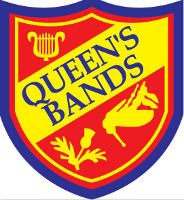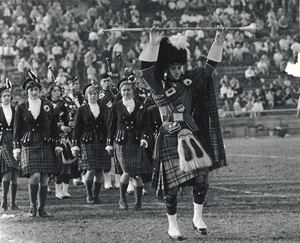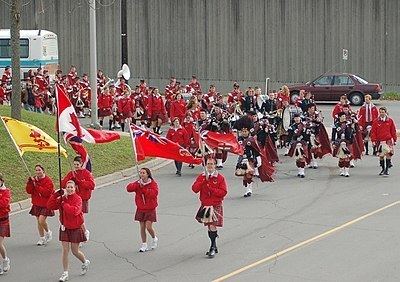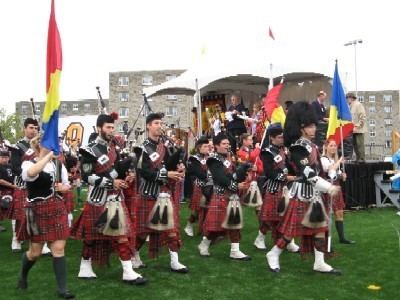Founded 1905 Fight song "Old Queen's Sweater" Active from 1905 | Members 120 Website www.queensbands.ca School Queen's University | |
 | ||
Location Kingston, Ontario Canada Uniform Varies by section but all wear the Royal Stewart tartan. Traditional Scottish highland uniform is worn by the Pipe Band and Drum Corps (green doublets) and Brass Band (red doublets). Colour guard wears red sweaters and kilts, Highland dancers wear traditional uniform. The cheerleaders wear white with red, yellow, and blue folded into their skirts. | ||
The Queen's Bands, established in 1905, is the largest and oldest current university marching band in Canada. They make their home in Grant Hall on the campus of Queen's University in Kingston, Ontario, Canada. The Bands operations are managed by students, and during performances the Bands are led by a Drum Major.
Contents

The Bands play a large role in promoting and maintaining school spirit at Queen's. The Bands comprise six distinct units (hence the pluralization of "Bands"): a pipe band, a drum corps, a brass band (which includes woodwinds as well as brass instruments), Highland dancers, the colour guard and cheerleaders including the Queen's mascot Boo Hoo the Bear. They are led by a drum major and the colour guard. The Bands perform pre-game and half-time shows at all Golden Gaels football games, and lead the crowd in singing the Oil Thigh after the Gaels score a touchdown. For home games, the Bands lead a parade of Queen's football fans from the main campus to the football stadium at the West Campus. Once football season ends they are active in festive parades, most notably the Toronto Santa Claus Parade for Christmas, and the Montreal St. Patrick's Day Parade. In the summer of 2012 they performed at the Calgary Stampede. They are also active during Frosh Week, and have also performed internationally, for example in the New Orleans Mardi Gras parade and the South Boston St. Patrick's Day parade. They wear traditional Scottish military dress, which the Bands recently purchased after with $250,000 in financial assistance from many donors, most notably the Alma Mater Society of Queen's and former Principal Bill Leggett.

The Queen's Bands is a volunteer organization, composed mainly of current undergraduates, but it also features some graduate students and occasionally some alumni among its ranks. Members of the Bands come from a wide range of musical backgrounds, however, since the main goal of the Bands, is to have fun and promote the Queen's spirit, this disparity in musical proficiency does not usually cause a problem. In any given year, the band is likely to have only two or three music majors.

The Bands' office is located in the John Deutsch University Centre, while their equipment vault is located in the basement of Grant Hall.

Queen s bands clumsy lover march 9 2013
History

The Bands was founded in 1905, when a group of first-year students decided to form a marching brass band "to help things along at football games." The idea did not gain easy acceptance. The 12 original musicians, which included John Bertram Stirling (Queen's chancellor from 1960 to 1974), suffered verbal abuse on parades to the football field and were ejected from the equipment room, where they practised, by the football team. The group dissolved after just two years, and it was not until 1920 that a marching band reappeared. The revived band, unlike the original group, had its own instruments and even uniforms: white duck trousers, tri-colour sweaters, and Queen's tams. The Queen's University of Kingston, Ontario tartan associated with the university and its pipe band includes the colours of six Queen's academic hoods: blue (Medicine), red (Arts & Science), gold (Applied Science), white (Nursing Science), green (Commerce & MBA), and Purple (Theology). The now traditional kilts and doublets were adopted only after the Second World War (the tartan worn by the Bands is the Royal Stewart (the official tartan of the Canadian royal family); they are the only non-military unit to wear this exclusive tartan). A pipe band was added to the troupe in 1925, but did not become a permanent fixture until 1938, at which time highland dancers also appeared. It is unclear when cheerleaders first joined the Bands. "Rooters clubs" were formed early this century to lead students in cheers at Queen's games and appear to have gradually become informally, and then formally, linked with the Bands. Currently, there are only 2 student run "spirit squads" in the OUA Queen's Bands Cheerleaders and the Queen's Dance Pack. The Bands takes care of the mascot of Queen's University, Boo Hoo the Bear.
Today the Bands are one of the most well-known groups on campus.

